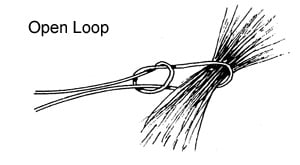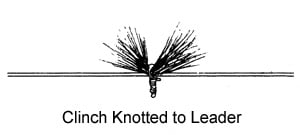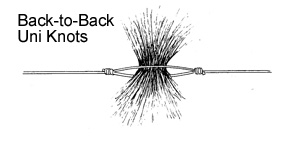Rigging Yarn and Dry Fly Indicators
IN THE FIRST PART of this article on strike indicators, I discussed the types of indicators available for spring creek and tailwater angling, and I identified yarn and dry fly indicators as two of the best methods. Below I have detailed several of the best ways to rig each type of indicator.
Rigging Yarn Indicators
I should note that there are now several types of commercial yarn indicators that can be purchased pre-rigged and are attached to the leader by various means. My objection to these is that most are too big for spring creek fishing and the attachment system may weaken the leader. Here are a few of the best methods is you choose to rig the yarn yourself.
Rig Yarn in Open Loop
One of the most commonly seen ways to rig yarn is to place a piece of yarn in an open slip knot loop and close the slip knot down to secure the yarn in place. This method will certainly work, but it has an number of disadvantages. If the loop is kept fairly open (around a thick chunk of yarn), the yarn may fall out or be launched out during casting. If a smaller piece of yarn is used, and the loop is drawn up tight, the leader will be kinked in the process. This is a particular problem with the larger diameters in the butt sections of copolymer knotless leaders. This method is quick and simple when the yarn is first rigged, but the resulting pigtail in the leader makes accurate casting nearly impossible and renders the leader useless for other fishing.
Rig Yarn at End of Leader, Tippet at Right Angles
A very efficient way to rig yarn for nymph fishing is to clinch knot the yarn at the end of fairly short, coarse leader (7 1/2 to 9′ with a tippet of 3X-4X) and then attach the actual tippet to be used by clinch knotting it around the standing end of the leader. This results in a tippet that comes off the leader at a right angle, which allows the fly to penetrate the surface film and sink quickly to fishing depth. This is one method that can be used to rig a big gob of yarn, if the angler is trying a suspend a bigger nymph in fast water. The biggest disadvantage to this method is that it produces a leader that must be changed or completely rebuilt for dry fly fishing, and this can be frustrating when the fish switch quickly from nymphs to emergers or duns in the course of a hatch.
Attach Yarn With Second Piece of Tippet Material
Another simple and effective way to attach yarn to the leader is to clinch knot a separate piece of monofilament around both the yarn and the leader. 3X or 4X material is easy to work with and strong enough to allow the knot to be drawn tight without fear of breakage, yet it doesn’t create unnecessary bulk. After the knot is tightened and trimmed, the yarn assembly can be moved up and down the leader. However, this method works best if the yarn is jammed against the tippet knot, as this helps keeps the yarn from moving accidentally, and changing the depth of the presentation. One advantage of this system is that the yarn and extra monofilament can be cut off to allow a quick change from nymph to emerger or dry fly, as long as the angler is careful not to cut the tippet in the process.
Rig with Back-to-Back Uni Knot
My favorite way to rig yarn for spring creek fishing was inspired by a diagram—seen 15 or 20 years ago—of yarn being inserted in a blood knot as the tippet is attached to the leader. When I show this diagram to fly fishing school students while they are practicing blood knots, they usually laugh out loud at the idea of adding an extra maneuver at the most difficult point in the operation. Even experienced anglers struggle enough with blood knots that inserting the yarn can be a daunting task.
My variation on this theme is to use a back-to-back Uni knot as the tippet knot, rather than a blood knot. The knot is easy to tie (and provides a nice, big gap in which to insert the yarn before the knots are drawn together), and the yarn is held securely in place. Best of all, the switch from nymph fishing to dry fly fishing is simple and quick. Grabbing the yarn between thumb and forefinger and pulling will separate the knots just enough to allow the yarn to slide out. The knot can be retightened (and retested), the fly changed, and the angler is set to go.
Rigging Dry Fly Indicators
Using a dry fly as the indicator require a rigging method that connects the two flies securely to the leader and to one another. Since an advantage of using two flies is that the “indicator” fly will also catch fish, the rigging method should also maximize the hooking potential of the top fly.
Although in most cases, the combination of flies will be an indicator dry fly with a nymph suspended below, a more visible dry fly can also be used to help detect a smaller dry fly or emerger on the point. Finally, even though the “indicator” is lost, the rigging methods described can also be used for attaching two nymphs to the leader.
I should note that since I started fishing a two fly rig with a traditional blood knot dropper, I refer to the bottom fly as the point fly as it is attached to the end (or “point”) of the tippet. When using this system, the dropper fly is the top fly in the rig. I make this explicit because many anglers (most of them from a new generation who never use a blood knot) refer to the bottom fly as the dropper, since it “drops” off the top fly. I know most readers aren’t really interested in the processes of semantic change (this reanalysis of a fishing term is an example of folk etymology and metonymy), but when anglers use the same word to mean very different (but closely related) concepts, it can result in miscommunication. To prevent confusion, I refer below to the fly positions as top fly and point fly.
Connecting the Point Fly to the Bend of the Hook of the Top Fly
Clinch knotting a piece of tippet and the point fly to the bend of the hook on the top fly provides a strong connection between the two flies, and it is the method I see employed most often by recent initiates to the “two fly” approach. Since the flotation in most dry fly designs (collar hackles, deer and elk hair wings, and clipped hair heads, for example) is concentrated at the head end of the fly, the weight of the point fly will tend to pull the rear end of the indicator fly through the surface film.
This can make the indicator fly harder to see, but in situations where the top fly is best presented as an emerger, it can also be a deadly technique. A great combination in a caddis hatch is an Elk Hair Caddis on top with a soft hackle emerger on the point. I usually trim the hackle and wing on the Elk Hair Caddis to get the fly to sit low, which results in a two emerger presentation—one in the surface film and one a few inches below the surface. An X-Caddis also works well as the top fly in this rig.
Connecting the Point Fly to the Eye of the Top Fly
Another way to connect two flies is to tie the tippet for the point fly to the eye of the top fly, rather than the bend. Although fitting two clinch knots on the eye of a fly can be a chore if the fly is small, this tends to preserve the floating angle of the indicator fly. It also keeps the tippet away from the gape of the top fly to prevent any hooking problems with the top fly. I don’t think it is common, but tying to the bend of the top fly may occasionally interfere with hooking.
Traditional Blood Knot Dropper
Since I almost always use a blood knot for attaching tippets (except when rigging yarn as described above), one of my favorite ways to rig two flies is still the most traditional—a blood knot dropper. By leaving one right angle tag end untrimmed, the top fly can be attached to this dropper and the point fly attached to the end of the tippet.
If you use this method, I can offer a few tips. Make sure to leave the dropper tag end long enough that you don’t have to struggle to tie the clinch knot to attach the fly. On the other hand, leaving the tag too long will invite tangling of the dropper around the leader. I usually leave 5-6″ to work with, and try to have the fly about 2-3″ from the leader after it is attached to the tag. Make sure the dropper tag is from the larger of the two diameters you are connecting. The stiffness of the thicker material will help keep the dropper at right angles and minimize tangling.
Experiment with these methods, and see which ones are most productive for you. You may find that certain rigging methods work best in specific situations, and knowing several different rigs will be advantageous.















